This is a Nikon EL2, a 35mm Single Lens Reflex camera produced by Nippon Kogaku K.K. of Tokyo, Japan in 1977. The Nikon EL2 was a replacement for the earlier Nikkormat EL/ELW from 1972. Like it’s predecessor, the camera featured a Copal Square electronic shutter with aperture priority automatic exposure, but improved upon it with a new metering system powered by twin Silicon Blue Cell (SBC) exposure meters, a slightly revised shutter speed scale, and support for new Automatic Indexing (AI) Nikkor lenses. The Nikon EL2 was also the first fixed prism SLR produced by Nippon Kogaku to be sold as a Nikon, rather than a Nikkormat. The Nikon EL2 had a very short life, being replaced by the functionally similar, but much smaller Nikon FE a year after it’s release.
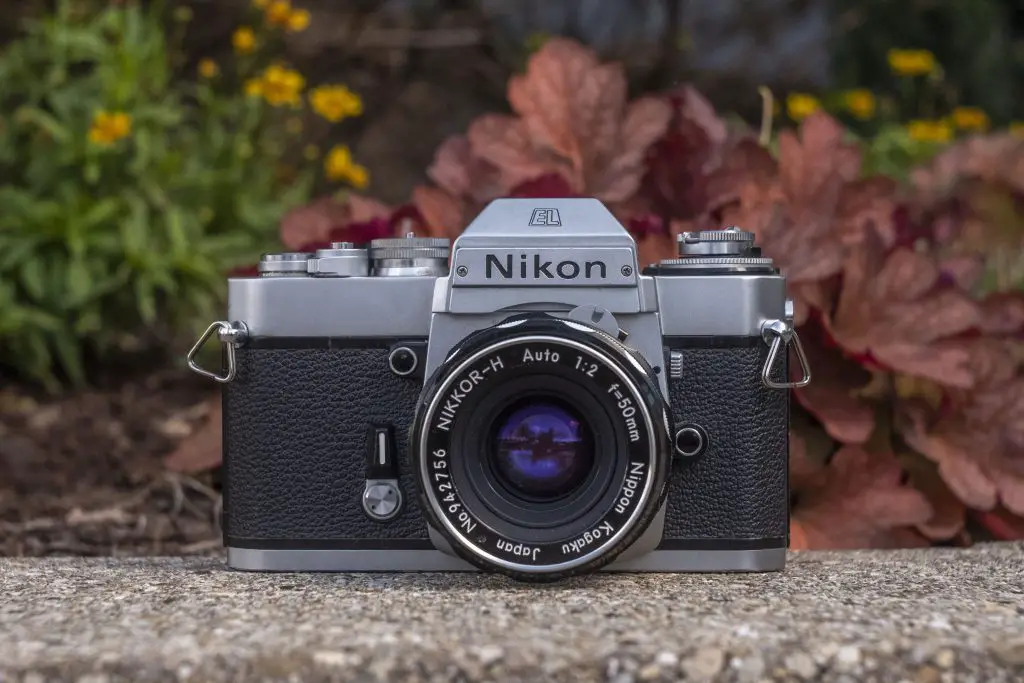 Film Type: 135 (35mm)
Film Type: 135 (35mm)
Lens: 50mm f/2 Nippon Kogaku Nikkor-H coated 6-elements + others
Lens Mount: Nikon F Bayonet
Focus: Variable
Viewfinder: Fixed SLR Pentaprism w/ split image and microprism circle focus aides
Shutter: Copal Square Vertically Traveling Metal Focal Plane
Speeds (Automatic): 8 – 1/1000 seconds, stepless
Speeds (Manual): B, 8 – 1/1000 seconds, 1/90 mechanical with no battery
Exposure Meter: 2x Silicon Blue Cells (SBC) and Aperture Priority AE, -1 to +2 EV override, AE-lock
Battery: 6v PX28 / A544 Battery
Flash Mount: Hot Shoe with M and X Flash Sync, 1/125 X-Sync speed
Weight: 993 grams (w/ lens), 773 grams (body only)
Manual: https://www.cameramanuals.org/nikon_pdf/nikon_el_2.pdf
Manual (alt version): http://cdn-10.nikon-cdn.com/pdf/manuals/archive/EL-2.pdf
Sales Manual: https://www.pacificrimcamera.com/rl/00385/00385.pdf
How these ratings work |
The Nikon EL2 is my favorite Nikon SLR and one of my favorite cameras ever. I appreciate the larger size and high build quality of the older Nikkormat body with the addition of modern features like an infinitely variable electronic shutter, twin Silicon Blue Cell exposure meters, an extremely bright and easy to use viewfinder, excellent ergonomics, and support for both AI and Non-AI lenses. This was my first Nikon film SLR and I’ll admit to having a bit of nostalgia for it, but even now, I cannot find any faults in it. I absolutely recommend this camera! | ||||||
| Images | Handling | Features | Viewfinder | Feel & Beauty | History | Age | |
| 2 | 2 | 2 | 2 | 2 | 2 | 0% | |
| Bonus | +Infinity for being the best camera ever made, with no faults whatsoever, no matter what you say… | ||||||
| Final Score | 2.91e+27 | ||||||
Prologue
 Back in the summer of 2014, I bought my first film SLR, a Nikon EL2. I cannot remember why I selected this particular model, but knowing myself, it’s probably because I thought it looked cool and it was cheap.
Back in the summer of 2014, I bought my first film SLR, a Nikon EL2. I cannot remember why I selected this particular model, but knowing myself, it’s probably because I thought it looked cool and it was cheap.
After getting that camera and shooting a few rolls of film in it, I quickly fell in love. That camera had some physical issues, so I replaced it with another that had more issues, and then I replaced it with another, which is the one being reviewed in this article.
I LOVE the Nikon EL2. I think it is perfect. This is my favorite Nikon SLR and perhaps one of my all time favorite cameras. My love for this camera is completely illogical. While there’s certainly a lot to like about it, I know that there are technically better Nikons, and even better cameras made by other companies, but I don’t care. I am a fanboy of the Nikon EL2.
Since starting this site, I’ve intentionally avoided reviewing the EL2 because I know I cannot be impartial to it, but I guess it’s time. What you are about to read will likely involve me going on and on gushing about the camera and be unable to see any of it’s faults. It is very likely that as you read this article, you’ll think to yourself, “Daaamn, Mike, why don’t you get a room already?!”
This prologue serves as a “Fanboy Alert” that what you are about to read is in no way going to be an impartial review. I’m not even going to try.
From the moment Nippon Kogaku started working on their first consumer camera in 1946, the company prioritized quality and perfection over innovation. Nippon Kogaku was the world’s first optics company with 100% inspection. Every single lens that was produced was hand inspected for imperfections and anomalies and any that were found, were destroyed. The light seal channels around the edges of the rear doors of early Nikon rangefinders were hand chiseled to perfectly match the bodies they were attached to. Serial numbers on the top plates of each camera were engraved, not stamped as it could warp the metal during the stamping process. Gaps exist in the serial numbers of many early Nikon cameras because some were destroyed before they were ever released because they weren’t perfect. This level of quality continued throughout the 1950s and the decades beyond.
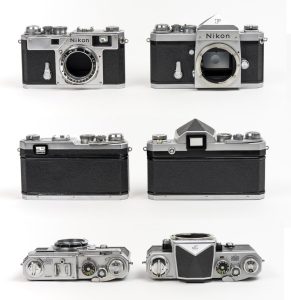
Nippon Kogaku was a small company in those days and their capacity for creating new products was less than that of other companies like Canon or Kodak. When the decision was made to start work on the first Nikon SLR, the camera had to be made with as many existing parts from the Nikon rangefinder as possible. With the exception of the mirror box and pentaprism, nearly 90% of the parts of a Nikon F are the same as the Nikon SP/S3/S4 rangefinders.
When the Nikon F was being built, Nippon Kogaku reached out to professional photographers all over the world asking them what they wanted in a pro-level SLR, and the message they heard unanimously favored quality and dependability over new technologies.
If you look at the specifications of the Nikon F, it didn’t have many firsts. Nearly every feature of the camera had previously been available on someone else’s previous model:
- Interchangeable Bayonet Lens Mount – First available on the Kine Exakta in 1936.
- Pentaprism Viewfinder – First introduced on the Rectaflex in 1948.
- Interchangeable Viewfinders and Focus Screens – The Exakta Varex in 1950.
- Instant Return Reflex Mirror – The Asahiflex IIb from 1954 had the first instant return mirror.
- Automatic Diaphragm for Wide Open Composition – The Contax/Pentacon F from 1956.
- Motor Drive Coupling – KW Praktina from 1952 had the first accessory motor drive.
In the years that would follow, Nippon Kogaku would maintain this ‘quality over innovation’ mentality waiting to release features like in-body meters, automatic exposure, auto-focus, and electronic shutters after someone else had already released it. This wait and see method worked for them as for much of the mid 20th century, no one directly competed with Nippon Kogaku.
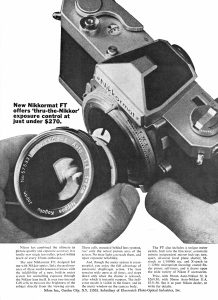
Not willing to sacrifice their market dominance of the Nikon F, in 1965, Nippon Kogaku would release a lineup of less expensive, but equally well built “advanced consumer” models called the Nikomat in Japan and Nikkormat everywhere else. The names Nikomat and Nikkormat are said to have been used instead of Nikon as the company was afraid to “dilute” the perception of it’s pro-level Nikon F with a “lesser model”. The Nikkormat used the same lens mount as the Nikon F and had a similarly high build quality, but more importantly, started to show a willingness for Nippon Kogaku to innovate.
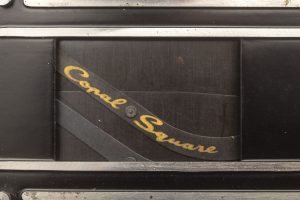
The first model was called the Nikkormat FT, and it had a fixed pentaprism viewfinder, an all new shutter speed dial around the perimeter of the lens mount, a vertically traveling Copal Square focal plane shutter, and an in-body match needle CdS exposure meter. A big benefit to the new Copal Square vertically traveling shutter was that by only having to traverse the 24mm height of the film plane as opposed to 36mm of horizontally traveling shutters, the amount of time the shutter blades are moving was decreased from 10ms to 7ms. This allowed for a higher flash sync time of 1/125 as opposed to 1/80 in the F2.
Like with the Nikon F and F2, the Nikkormat FT wasn’t the first to offer any of these features, but it at least showed a desire by Nippon Kogaku to experiment with new-ish features.
The Nikkormat was very successful and despite it’s stance as a less-professional camera, they became favorites of professional photographers as backups to their Nikon F and F2 SLRs.
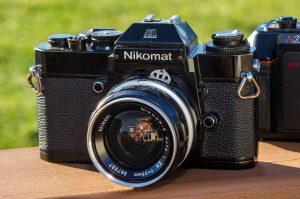
In 1972, a new camera called the Nikkormat EL would make it’s debut with several significant improvements. It was the first Nippon Kogaku SLR with an electromechanically controlled shutter and aperture priority automatic exposure. The Copal Square shutter was still mechanical, but used solid state electronics and magnets to control the timings. Although the shutter required power from a 6v battery to fully operate, it’s electromechanical design meant it could still operate without power at a single 1/90 shutter speed.
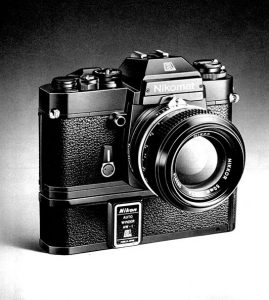
The EL was produced until 1976 when a revised model called the ELW replaced it. The ELW externally looked almost identical to the EL, but had four upgrades. It was geared to work with Nikon’s AW-1 battery powered auto winder which allowed for 2 frames per second, it received an improved Copal Square ES shutter that added an 8 second shutter speed, a lock ring around the shutter release, and it received Nikon’s type K focusing screen.
Finally, in 1977 came the EL2, which would officially end the Nikkormat lineup, and would be Nippon Kogaku’s first SLR outside of their professional F and F2 series to be called a Nikon. The EL2 had all of the upgrades from the ELW including the same improved Copal Square ES shutter and support for the AW-1 auto winder, but also upgraded the exposure meter to Silicon Blue Cells which were much more accurate, added an exposure compensation dial, and added support for Nippon Kogaku’s new Automatic Indexing or AI lenses. The camera was available with either a chrome or black finish.
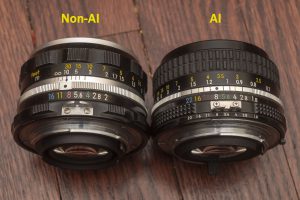
Nikon SLRs that support AI lenses no longer require a moving pin to sit between a two pronged metal tab on the outside of Nikkor lenses. Many people refer to these prongs as “bunny ears” and were how early Nikon SLRs were able to detect the aperture setting on the lens for exposure calculation. With the AI system, first introduced a year earlier with the Nikkormat FT3, lenses can be easily mounted to a body without having to line any prongs or levers up. Once the lens is attached, the camera body will always know not only what f/stop is selected, but also the fastest speed of the lens.
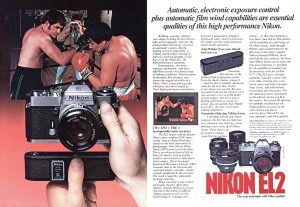
The Nikon EL2 was Nippon Kogaku’s most sophisticated camera. It featured a state of the art exposure metering system, a shutter capable of stepless speeds from 8 seconds to 1/1000, it offered aperture priority automatic exposure and match needle manual exposure, and supported Nippon Kogaku’s full range of lenses available at the time.
In accordance with it’s high-end specs, the EL2 also came with a high-end price. When it was new, the retail price of an EL2 varied between $637.50 with a Nikkor 50mm f/2 lens and $831 with the Nikkor 55mm f/1.2 lens. These prices compare to $2580 and $3400 today making the EL2 quite an expensive option despite not being considered a “professional camera”.
In the 5 page test of the EL2 from the April 1978 issue of Modern Photography above, the editors repeatedly praised many of the EL2s operations from the bright and extremely easy to use viewfinder, to the accuracy and responsiveness of the new SBC exposure meter, to the new AI system and how easily it is to mount lenses. Later in the review, they proclaim the EL2 as one of the best handling SLRs out there and finish off the article by saying “There is no more rugged, reliable auto exposure SLR around.”
The following two pages are from a large sales catalog distributed to Nikon dealers in 1978 laying out the specs of the camera to help educate those who would sell it.
The EL2 turned out to be a stopgap model that was only in production for one year. The model that replaced it was the Nikon FE that supported nearly all of the same features, but in a smaller, and lighter weight body. The more compact design of the FE and it’s all mechanical brother, the FM, was something every other major SLR manufacturer had been doing, so it was time for Nippon Kogaku to downsize as well. Both the FE and FM would go on to be immensely successful models, staying in production for five years each before being replaced by the FE2 and FM2 which were produced even longer.
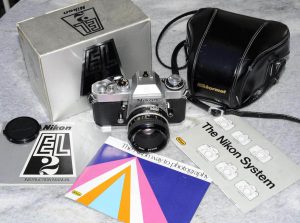
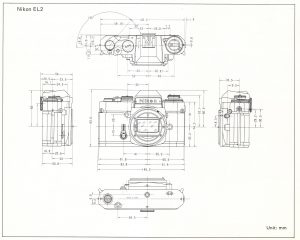
I was unable to find any estimates of how many EL2s were made. I can’t imagine the number is very high as the camera was only in production for about a year and with a price that compares to around $3000 today, it would not have been affordable by many people. Still, I see them for sale with regularity on eBay. Prices are all over the place considering this isn’t a model in high demand. As I write this, I’ve owned 4 different EL2s of which I still own 2, and I’ve never paid more than $40 for one with a lens, yet some sell for upwards of $150 – $200 so your mileage may vary.
Today, the Nikon EL2 isn’t the first, second, third, or heck, probably even tenth most popular Nikon camera. I won’t go as far as to say it’s an unheard of model, it’s just not one that many collectors or people still shooting film today would seek out. For me, this was my first Nikon SLR and I loved it, partially out of not having anything else to compare it to, but as I’ve come to realize in the years since getting that first one, the Nikon EL2 has one of the best combinations of modern technology and convenience in an “old school” full size, rugged, heavy metal body.

My Thoughts
This is my third (and fourth) Nikon EL2 and the one that’s been in the best condition. My first was purchased in the summer of 2014 prior to writing my first camera review and at the time, it was just ‘some old camera’ to me. I quickly became fond of that camera, loving it’s large and sturdy metal body. I loved the “cha-chink” sound of the shutter firing and the reflex mirror flopping about, and I loved the analog display inside of the viewfinder.
That camera had a big dent on the top plate, the pentaprism was desilvering, the Nikon logo was partially chipped off, and the camera just showed heavy signs of use so I sold it…and regretted it….so I bought another, but that one had an even worse prism, and the meter was off, so I sold it…and bought another, and well, this is that camera.
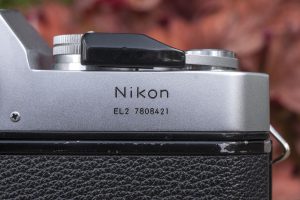
Despite being called a Nikon, the EL2 is still part of the Nikkormat/Nikomat family, sharing the same body and many of the same features of the earlier Nikkormat EL from 1972. Like that camera, the EL and EL2 are the only two Nikkormats to have a shutter speed dial on the top plate of the camera instead of around the lens mount like the Olympus OM-series.
Also like the EL and Nikon’s later electronic shutter cameras through the FA, the camera can still fire it’s shutter at a single 1/90 mechanical shutter speed if the camera loses power allowing for continued use with a dead battery.
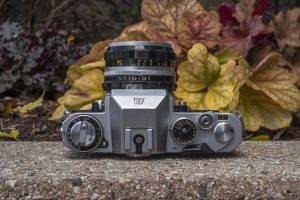
The EL2’s control layout gives the top plate a familiar and modern look and feel to it. The order of the controls is pretty close to the same as most Nikon SLRs that would come until the auto focus era, but being on the larger Nikkormat body, everything is just a bit more spread out. This of course, is ideal for people with medium to large hands. Nothing about the layout of controls feels cramped.

Comparing the EL2 to the original EL, there’s only minor visual differences. The ASA film speed dial supports an expanded range from 12 to 3200 (up from 25 to 1600), there’s a manually selectable 8 second shutter speed (up from 4 seconds), and there’s a shutter lock around the shutter release, but otherwise everything else is the same.
Also like most metered Nikon SLRs, the plastic tipped and angled film advance lever serves a double function as the camera’s power switch. With the lever pulled back roughly 30 degrees from it’s resting position, the meter is powered on and ready to go. This is something that I’ve heard many photographers complain about that Nikon SLRs poke them in the eye when the lever is in this “out” position, but it’s something that has never bothered me.
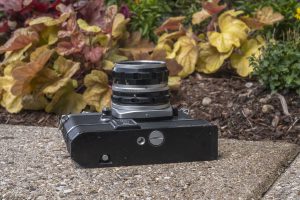
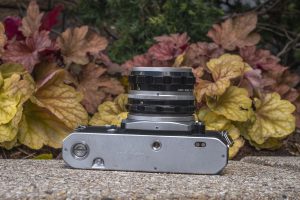
The bottom plate of the EL2 is geared for the optional AW-1 motor drive, which you can see with and without in the two images to the left.
In addition, there is the button for rewinding film, a centrally located 1/4″ metal tripod socket, and a small electrical contact for the motor drive. On the bottom of the motor drive is a large screw for attaching it to the camera’s tripod socket and an alternate tripod socket for using the camera on a tripod with the motor drive attached.
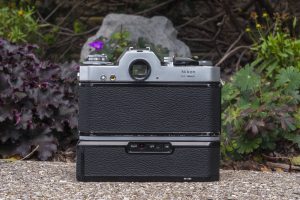
The back of the camera has a circular eyepiece for the viewfinder which can be unscrewed and replaced with a variety of screw-on diopters and other accessories that were available. To the left of the eyepiece is a battery check button and light. This light seems to be the weakest point of the entire camera as of the three EL2s I’ve owned over the years, I’ve never had one where this light worked, despite the camera having power. Finally to the right of the viewfinder is the camera’s serial number which begins with “EL2”. This is the only place on this camera that indicates what model it is, making them a bit more difficult to find on the used market if someone doesn’t know what it is.
With the AW-1 motor drive attached, the back is also where you’ll see a red pilot light to indicate the drive is working, and an ON/OFF switch.
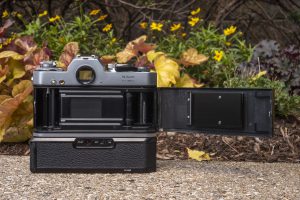
Opening the film back of the EL2 is just like any other Nikon SLR, which require a simultaneous tug of the rewind lever while putting pressure on a black door release lever beneath it. With the door open, you can see a pretty typical film compartment. Film transport is from left to right onto a double slotted non removable take up spool. On the inside of the door is a smooth film pressure plate with curved edges and a film roller to ensure film flatness. The image to the right was taken before I replaced the light seals, which like nearly all 1970s SLRs were crumbling and degraded.
Like the original Nikkormat EL, the shutter is a Copal Square vertically traveling metal shutter. In addition to being electronic and supporting infinitely variable speeds, it also offers a faster flash sync speed of 1/125 seconds which is up from 1/80 on the Nikon F2 with it’s titanium horizontally traveling shutter.
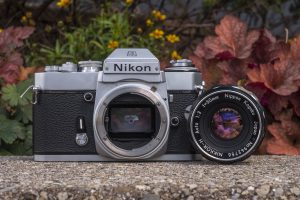
Like all Nikon SLRs, the EL2 has the tried and true Nikon F Bayonet mount. A release button is located at the 3 o’clock position around the lens that when pressed, a quick twist of the wrist is all that’s needed to remove the lens.
Immediately above the lens release button on the side of the mirror box is a mirror up switch which raises the reflex mirror and keeps it in the up position until you lower it again. Cameras with this feature usually have it for macro exposures where you don’t want to introduce camera shake from the reflex mirror at extreme closeups, or for adapting special lenses that protrude into the mirror box. While both of those reasons are valid for the EL2, this feature exists for another reason which I’ll get to later.
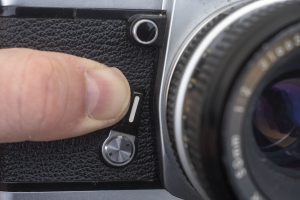
The EL2 features what looks like an ordinary 10 second self timer on the front of the camera, but it hides two features that might not be obvious. The first is that upon setting the self timer and pressing the shutter release to begin the timer countdown, the reflex mirror immediately rises to the up position and stays there until the countdown is complete and the shutter fires. This is useful in long exposure or macro photography by eliminating body shake from the reflex mirror lifting the moment before the shutter fires.
The other feature is that the self-timer lever also doubles as an AE-lock function for shooting in difficult light where it is necessary to take a meter reading first, and then recompose your shot without losing the exposure reading. To use this feature, with the camera pointed at whatever you want to take an exposure reading from, press the self-timer lever towards the lens mount and hold it there. This activates the AE-lock. Then with your finger still on the lever, recompose your shot to how you want it captured and fire the shutter. With the AE-lock on, you can point the camera at whatever you want, and the meter will remember the previous reading from before you pressed the lock. A word of caution however, is that with the AE-lock on, the meter needle in the viewfinder will continue to fluctuate as the light changes, even though the reading is already locked in, so you can ignore whatever it says.
Unlike the earlier Nikkormat EL, the EL2 supported Nikon’s new Automatic Indexing (AI) lenses which no longer require lining up a pin on the camera to the two pronged metal tab that came on most Nikkor lenses of the day. This greatly simplified lens installation as it was no longer necessary to rotate the aperture selector on the lens back and forth to “set” the camera after installing a new lens. The new AI lenses were backwards compatible with older bodies, but older non-AI lenses were not forward compatible with newer bodies as the AI system required a notch be removed from around the lens’s collar, something non-AI lenses did not have.

Nippon Kogaku realized that many potential customers of the EL2 would likely have non-AI lenses, so they added a clever little button near the 1 o’clock position around the lens mount that when pressed will flip up the AI pin out of the way, allowing for the installation of non-AI lenses. This flip up AI pin would also be included on the later Nikon FM and FE, but not the later EM, FE2, FM2, or FA cameras. When using a non-AI lens on the EL2, the metering circuit only works when manually stopping down the lens using the depth of field preview button near the 10 o’clock position around the shutter.
Perhaps one of the most confusing features of the EL2 is a hold over from the original Nikkormat EL, which was the location of it’s battery compartment inside of the mirror box beneath the reflex mirror.
I mentioned earlier that the mirror up switch was useful for reducing shake caused by the mirror moving during macro and long exposures, for allowing the installation of specialty lenses that interfered with the mirror, and that it served a third purpose which I would get to later. Since the EL2 wasn’t created as a professional’s camera where those first two scenarios would be needed often, it’s presence on this model was likely included to move the mirror out of the way to change the battery.
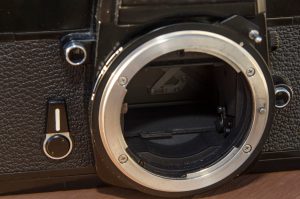
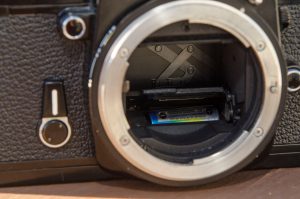
Both of the images to the left and right were taken on the Nikkormat EL which has an identical battery compartment.
With the mirror in the up position, you can see the battery door on the bottom of the mirror box. On the left of the door is a little tab with an arrow on it. Using your finger, press this tab in the direction of the arrow and the door will open. Then turn the camera upside down, and gently press the inside of the battery door towards the back of the camera and the battery will be ejected out of it’s compartment and fall into your hand. This process isn’t hard, but it’s close location to the shutter means that extreme care should be used to avoid accidentally poking the inside of the shutter’s blades. With the battery out of the camera, insert a new battery in the opposite of how you removed the old one and you’re done.
In the years since the EL2’s release the location for the battery has been heavily criticized, but I actually prefer it compared to the typical round battery compartments found on the back or bottom of cameras that require a coin to remove. For starters, the entire process of changing a battery can be done entirely with your fingers and without the need for an appropriately sized coin. I am sure when this camera was new in 1977 people walked around with coins in their pocket all the time, but I hardly ever carry cash these days, so opening a camera’s battery compartment has actually been a challenge for me on occasion as it likely has for previous owners as MANY old cameras in my collection have moderately to severely chewed up battery doors. Plus, with the EL2’s solution, there’s no chance of losing the door as can happen with other cameras if you aren’t careful.
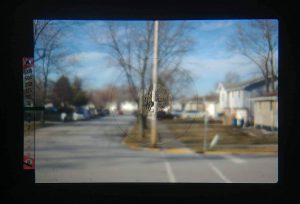
With the camera loaded with film and ready to shoot, your biggest impression while using the EL2 is looking through it’s viewfinder. If you’ve ever used a Nikon FE or FE2, the layout is very similar because those cameras both evolved from the EL2.
Also like it’s successors, the EL2’s viewfinder is very bright, even at the extreme corners. Comparing the viewfinder with a sub f/2 lens to that of the Nikon N90s from the mid 1990s, I’d say the EL2 is marginally brighter as it doesn’t have the liquid crystal focus confirmation overlay on the focusing screen which has a tendency to reduce brightness on modern SLRs.
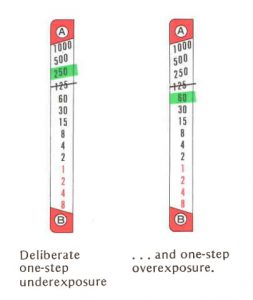 The analog shutter speed scale on the left gets it’s brightness from the light passing through the lens which means if you are using the camera indoors, or in low light situations, it may be difficult to see the readout. This is one of the few usability issues with the EL2, but it could be forgiven as back lit displays did not become common until years later.
The analog shutter speed scale on the left gets it’s brightness from the light passing through the lens which means if you are using the camera indoors, or in low light situations, it may be difficult to see the readout. This is one of the few usability issues with the EL2, but it could be forgiven as back lit displays did not become common until years later.
The analog scale features one of the EL2’s greatest attributes, which is that in Auto mode, the black needle displays the shutter speed that it will use when the shutter is fired, but in Manual mode, a second green needle shows what speed you’ve selected, and the black needle continues to make recommendations based on available lighting. This, in essence turns the display into a match needle readout, in which when both the black and green needles line up, you’ll have correct exposure. If you want to intentionally over or under expose a shot, you simply select a shutter speed or f/stop combination that makes the green needle above or below the black needle. Although the EL2 does have a +/- EV switch on the top plate, I find adjusting exposure this way to be much faster.
There is a heck of a lot to like about the Nikon EL2. Some of the camera’s best features are hold overs from the Nikkormat era, yet it contains a boat load of modern technology that would be later reused in the excellent FE/FE2 series. Over the years, the complaints I’ve heard about this camera is that they’re unreliable, have a horrible location for the battery, and that they’re not up to par with later Nikons. I disagree on all three fronts. For starters, while my sample size is still small, I’ve come across 4 of these cameras and all worked. As for the battery location, it might be weird, but at least it still uses a commonly found battery unlike many others that don’t, and comparing it to later Nikons, I think it’s better for all the reasons I’ve already discussed here. Of course, if you’ve made it this far into this article, you want to see some samples, so keep reading…
My Results
Having owned multiple EL2s over the years, I’ve shot a variety of them several times. I was hesitant to ever do a full review for the reasons I state at the beginning of this review, but now having decided to do it, I went through my various folders that I had images saved in and picked a few out. The ones of me in the mirror and at the hockey game are shot on Fuji 400, but the older ones, I don’t know. They’re probably either Fuji 200 or 400 as that’s the color film I use the most often.
I won’t spend much time talking about the images in the gallery above as they’re all typical of any SLR that uses Nikkor lenses, whether it’s a Nikon EM or an F6.
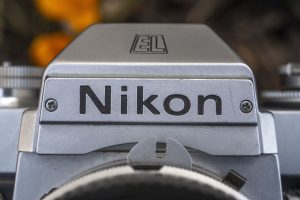
I started out this review with a “Fanboy Warning” that this is a camera that I irrationally love and can’t find any faults in. Can you blame me though? What other camera has this combination of features:
- Tank-like build quality of the Nikkormat-series
- Large, but not too large, comfortably spaced control layout and ergonomics
- Supports Nikon’s Ai and Ai-S lenses plus the earlier non-Ai lenses
- Infinitely variable electronic shutter with speeds from 8 seconds to 1/1000
- Full manual control of aperture and shutter speeds with match needle metering
- Modern Silicon Blue Cell photocell for accurate aperture priority auto exposure
- + / – EV compensation dial, plus AE-lock feature
- Both a mirror up lever, and mirror goes up when activating the self-timer
- Shutter still works with no power at a single 1/90 speed
- 1/125 X-sync (not as impressive compared to 1990s SLRs, but for a 1977 camera, that was wicked fast)
- Extremely bright viewfinder with corner to corner brightness that compares favorably to SLRs released decades later
- Viewfinder display showing recommended and manually selected shutter speed with match needle capability in full manual mode
- Supports AW-1 motorized film advance motor
- No tools or coins needed to change battery and impossible to lose battery cover
The cons?
- Weird location for the battery
- Battery check light goes out
Looking at the list above, you’d be hard pressed to find another 35mm SLR from Nikon or any other company that has that balance of features that so overwhelmingly favors the “pros”. Maybe my love for this camera isn’t unjustified as it fits my hands and style perfectly, the viewfinder works great with my poor vision and prescription glasses, it has every feature that I could ever need from a classic SLR, and it just works.
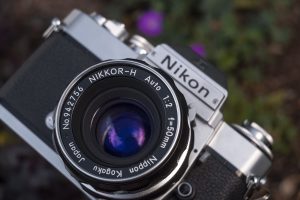
As recently as the 1970s, Nippon Kogaku’s reluctance to release cutting edge technology until they had worked out the kinks was still alive and well in cameras like the Nikon EL2. Sure, the FE was just one year away from being released, and some may prefer it’s more compact and lighter weight body, but everything that made the FE (and later FE2) such great cameras was in the EL-series first.
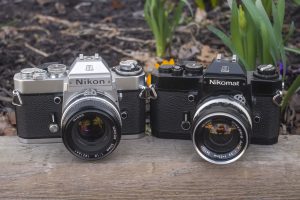
Comparing the EL2 to the EL and ELW, the SBC meter in the EL2 gives a significantly faster response to changing light conditions than the older CdS cells did. Point the EL2 at a bright sunny sky and see the needle in the viewfinder shoot up, quickly tilt the camera down into a shady area and the needle instantly responds. In every EL or ELW I’ve had the response is much more sluggish and sometimes even takes a second or two to stop bouncing around when moving between scenes of high and low contrast.
The use of newer AI and AIS lenses is a plus too as it makes lens installation a snap, and in my personal collection, I have more of these lenses so I’m more likely to use them.
So, there you have it, my take on the Nikon EL2. Like I said at the beginning of this review, I acknowledge that I am an EL2 fanboy, and I likely wouldn’t see any faults in it, so I am really curious to hear your thoughts. Is the EL2 a camera you’ve handled before and can agree with my fondness to it, or am I illogically smitten by a flawed camera? Let me hear your thoughts in the comments below.
Related Posts You Might Enjoy
External Links
http://www.mir.com.my/rb/photography/hardwares/classics/nikkormat/elseries/el2/index.htm
https://www.kenrockwell.com/nikon/el2.htm
http://www.photographic-hardware.info/nikon_manual_focus_slr_film_cameras/nikon_el2_camera.htm
https://www.678vintagecameras.ca/blog/nikonikkormat-el-nikon-el2-nikon-plugs-in8322302

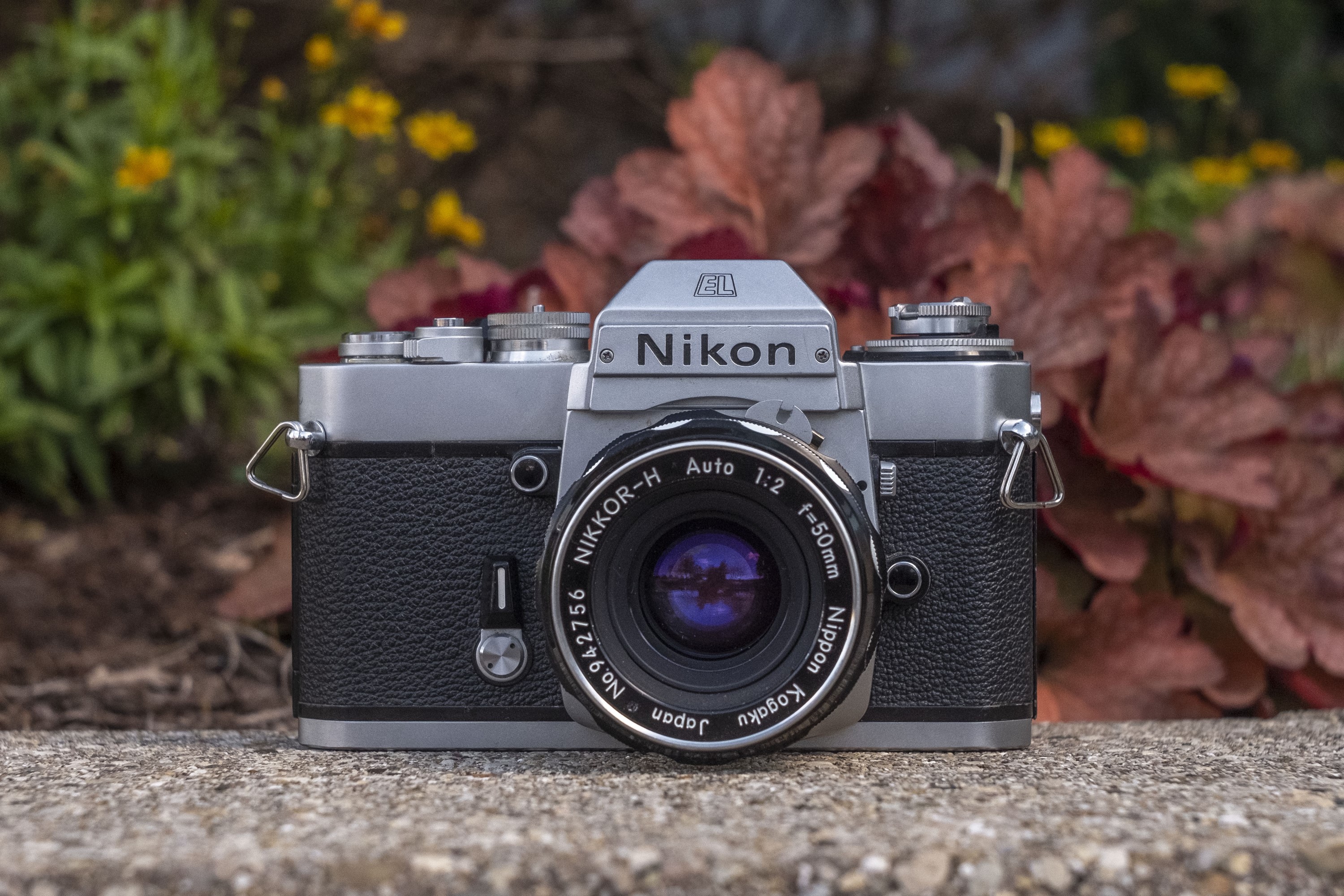
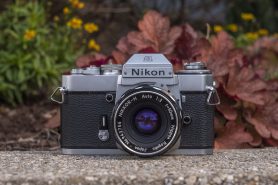
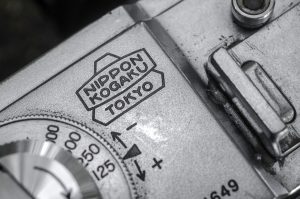
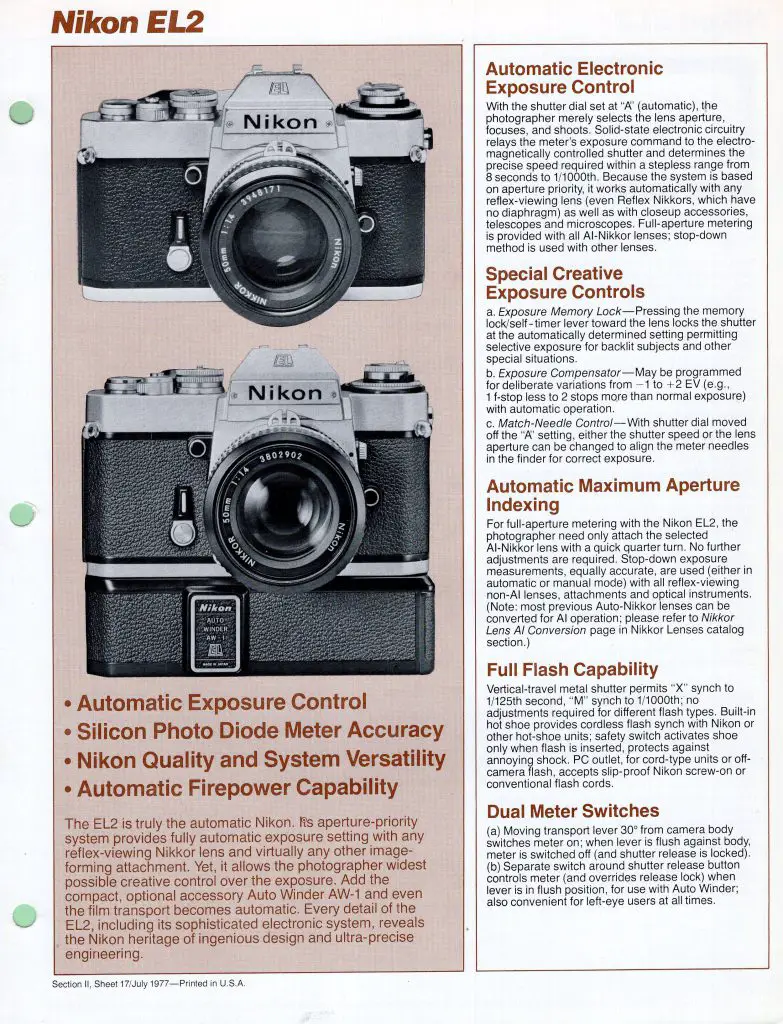
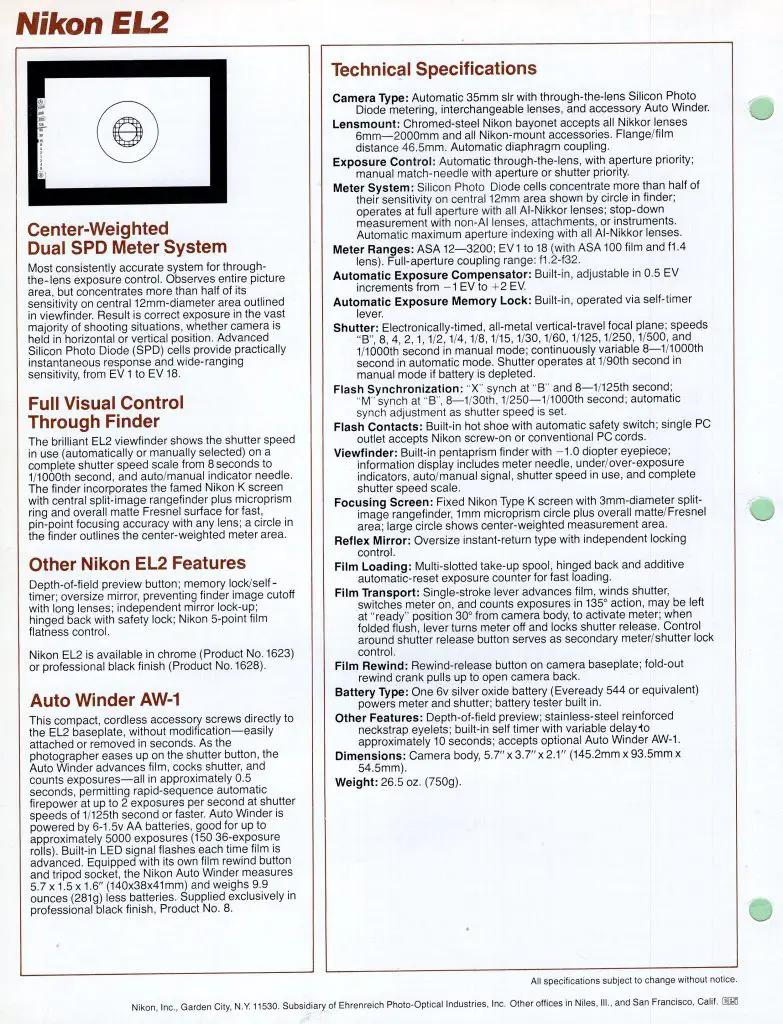

















Another great and very thoughtful review Mike. I seem to have wound up with several EL and EL2’s that I bought in lots or to obtain a lens they were wearing. Mine all work except for the ELW which works occasionally. I like them so much I had several serviced, which wasn’t cheap. I like heavy metal, so I prefer these to the FM and FE’s. The complaints about the battery compartment falls on deaf ears here, what’s the big deal? I don’t hear a lot of complaints about the doors on Canon A-series cameras which I find much harder to use and not break. Like you I have poor vision so I put a LOT of stock in your SLR reviews. Hats off to the EL series!
Thanks for the compliments Jon! I think some people just like finding things to complain about and the EL2’s battery compartment is an easy target for some since it’s different, I guess. It’s never been an issue for me, and like I point out in the article, it’s one of the few classic cameras that allow you to change the battery without any tools or the chance of losing the cover! How many Pentax Spotmatics can be found with missing or totally chewed up covers?
The EL2 is perfection for me, which is why it took me so long to write about it. If you like larger, nearly perfect heavy metal SLRs, you’ll enjoy my review coming up on May 12th! 🙂
Agreed, Mike, that this is a fine, heavy, solid old-school SLR. Check listings on That Auction Site and you discover that, akin to late-model Pentax K1000s (the ones made in China), the EL2 seems to suffer prism fungus. Short of buying a parts donor body, or squinting around the ugly black tracery, a prospective EL2 buyer needs to be on the lookout for this problem.
Sadly, prism rot got more and more common with cameras into the late 70s and 80s. The first two examples I had (both of which I got rid of), had this issue. Thankfully the second pair which I still have, do not.
Thank you for passionate article about the EL2.
I share your love, I own a lot of Film Nikon’s (too many if you ask my wife…) and even with all that choice I still love to grab my EL2 with a nice Portra 800 and start shooting!
The reason why I write you is that I recently bought a nice EL2 which puzzled me. It was absolutely an EL2, but the serial was way off. Instead of the EL2 78xxxx numbering this one has serial 5703636 without the EL2 prefix.
Today I learned from Nico van Dijk (www.nicovandijk.net) it actually is 100% an EL2, but the serial indicates it is a Japanese market only model, so they kept counting after the Nikkormat ELW serial Only the export models got the new EL2 78xxxxx numbers.
Well, Mike, it took a week and a half since I read this post to find a clean and working (and black) EL2 with a 40mm f1.8 Ai Nikkor on That Auction Site for $45 plus shipping. The seller says there’s light dust in the viewfinder but no fungus. You, sir, cause many of us a lot of GAS … !
I’ve just bought an almost mint example of a Chrome EL2 for £45.00, I’ve had a black version for over 25 years and I couldn’t resist such a bargain and like you I have many later Nikon’s like F3HP’s, FA’S and FM’s etc, there’s a certain something I like about the EL2 not withstanding it’s all metal construction, it’s a vastly underrated Nikon that’s for sure and I’d forgotten how expensive it was back in 1977, it looks and feels like a proper Nikon and in experienced hands its capable of outstanding results ( just like me for instance!) sorry about that!! if you can’t blow your own trumpet nobody else will! but seriously if you’re on a budget and own a handful of either Nikon Ai or Ais lenses and looking for a cheap 2nd body as a backup you could do a lot worse than buy an EL2 in good condition, there’s still plenty out there even as you pointed out the production run only lasted a year or so, I really enjoyed reading your review which to me sounded a lot less commercial than reviews from Mr Rockwell etc
Well said, there’s much to like about the EL2s. They’re that rare middle ground between the electronic FE and the large mechanics of the Nikkormat!
Mike, I’ve owned my 2 EL2’s since the were introduced in1977. I have a chrome and a black body. I also still have a Nikkor-S Auto 1:1.2 f=55mm lens I use on them. It’s an extraordinary combination. I have since acquired a Carl Zeiss 1:1.4 50mm, and a VOIGTLANDER 1:1.4 Nokton 58mm lens. I have also converted a Carl Zeiss 1:2.8 80mm lens from my Rollie SL66 to fit the F mount. All lenses produce excellent images on the EL2’s. I will continue to use them with hopes for good images. Never turn down an opportunity to make a fine image. Best wishes.
Excellent article.
My recollection in the UK was that the Nikkormat FT3 and Nikon EL2 were introduced at pretty much the same time and actually shared advertisments. I think those adverts claimed that the upgrade to the Nikon name for the EL2 was based on a decision to apply that name exclusively to cameras which accepted power winders and motor drives. I expect, though, it is generally accepted it was really done as a selling point for a camera that was priced at semi professional level or more :))
Indeed, at the time, the Nikkormat FT3 model looked like a long in the tooth design for the demands of the contemporary marketplace having neither the features or adaptability of similarly priced yet lighter and more compact Olympus and Pentax models. As you say, this was soon later addressed by the more expensive Nikon FM model.
Came across this while deciding on what to replace my Nikomat EL with (it has developed a persistent fault in the meter coupling assembly). Think I’ll be going with an EL2 over an FE/FE2 – I do a lot of macro so mirror lock-up is actually pretty useful.
Just wanted to note that the original EL’s shutter speeds may only be marked up to 4 seconds, but the camera will still give you 8 seconds if you put the shutter speed dial between “4” and “B,” even though there’s no detent. Best explanation I’ve heard is that Nikon intended for the EL to go up to 8 seconds, but wasn’t happy with the 8 second setting for whatever reason. Rather than actually eliminate it, Nikon just hid it.
This is interesting! I will have to check that out the next time I dig out my EL. I haven’t touched it in years however.
I like a person who stands for something! I also am fond of the EL2, though perhaps without quite the level of enthusiasm that you display! Mine has been sitting for a couple of years (I have an F2, FM2, Nikkormat FT2 plus some Minoltas, so everybody has to wait their turn). What struck me the first time I picked up a Nikkormat EL was that it felt like an FE that wouldn’t break if I dropped it! I eventually sold the EL and got an EL2, and it is indeed a lovely camera. Thanks for the detailed review, which alerted me to the exposure lock, which I previously didn’t know about.
I have owned the EL2 since the year it came out and it has been a great camera. It is in prefect shape. I am thinking of selling it. I also have an extra. what would a good price be for this equipment.
Valuating a camera is tricky. Condition (even if it looks nice, does it work?) which lens, and anything else you have included with it affect it’s value. The EL2, for as good of a camera as it is, was never a high demand camera. It wont fetch anywhere near what an F2 or F3 would. Right now is also not a good time for selling cameras. I know several big eBay sellers and they all tell me inventory is moving really slowly. Sales will likely pick up later in the year. If I were you, I’d keep the camera as it has some historical significance to you. If you absolutely want to sell it, I’d wait til it gets closer to the end of the year, and then list it on eBay with a low opening bid and let people bid it up. Whatever the final bid price is, is what it’s value is. Good luck! 🙂